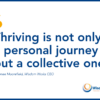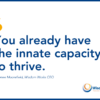We need a new standard of thriving to guide our organizations—where “engaged and thriving” is the norm.
 When pressed, I think most leaders would say that people who are engaged at work produce better outcomes than people who aren’t engaged. Yet, the Gallup organization, canvassing a staggering 160 million employees worldwide, found that if employees are engaged at work, but not thriving in their lives, the organization is likely struggling.
When pressed, I think most leaders would say that people who are engaged at work produce better outcomes than people who aren’t engaged. Yet, the Gallup organization, canvassing a staggering 160 million employees worldwide, found that if employees are engaged at work, but not thriving in their lives, the organization is likely struggling.
Employees who are “engaged but not thriving” show considerably more stress, worry, and burnout than employees who are both engaged and thriving. The organization bears a productivity and financial loss too; employees who aren’t thriving report greater absenteeism, health challenges, and disease due to depression, anxiety, high blood pressure, chronic pain, heart attack, and diabetes.
I wasn’t surprised at these recent Gallup findings. For over 30 years, my teams have been guiding leaders to prioritize ‘thriving’ in their work cultures and brands, as well as in how they lead people, tasks, initiatives, and teams. Early on, we realized leaders who are perpetually overextended, tense, or depleted, are more apt to lack the stamina, clear-headedness, emotional balance, and world-centric acumen to bring about the best decisions from others or themselves. They cannot draw from the reserves of energy and wisdom that are available when they lead from a foundation of wellbeing.
This is true for us all. When we aren’t ‘thriving’, what are the effects? Eventually our work, organizations, and loved ones suffer.
WHAT DOES IT MEAN TO THRIVE?
I’ve explored this kind of question with thousands of leaders across industries and am inspired every time I ask. I’m curious how leaders define concepts such as ‘thriving’ and ‘wellbeing’, and in particular, what these ideas mean to their identity, values, focus, and behaviors as a leader. A few answers leaders have shared over the years are:
- “Thriving is about being fully human at work—how we can leverage all of our innate and learned capabilities to create better organizations and to work together more effectively. To me, it’s about contributing to people’s greater awareness of what allows them to lead a happy and meaningful life.”—Healthcare executive
- “Thriving means having the tools to do your job, but also the energy.”—Digital transformation executive
- “True leadership involves the ability to create that space that’s conducive to wellbeing. It’s about creating the environment that enables people to achieve and strive for their own personal wellbeing, whatever that might look like, whether it’s their family, physical health, something that they’re passionate about in the community, their career progression, a combination of all of that.”—Athletic footwear and apparel executive
- “It’s about bringing the human element back into the paradigm of work as an organizing principle.”—Military leader
- “It is about elevated human consciousness; a worldwide awakening of the social and emotional skill level of people is going to happen at work. The role of business in what’s next for the human race is profound. Anybody who is working at a corporation today should see the heroic role that they have to play in making this come about. We’re finally in a place where people are recognizing that this [human thriving] is how the best work gets done…”—High-tech executive
These leaders point to a deeper shift in understanding their roles and themselves. Thriving is at the heart of real leadership. Enlightened leaders continually ask, “How can we create the conditions for people to bring their best selves to work, plus leave work more capable and energized than when they came?”
Thriving is a natural state of human functioning—a hard-wired biological capacity—and as such, it is the basis of human potential, development, and optimal performance. When faced with complexities and demands, our wisest solutions will more likely come from operating out of a sense of expansiveness and wellbeing, rather than reactivity and overstress. Why? When we internally feel well-resourced, we naturally bring more energy, adaptability, emotional balance, optimism, and wisdom to situations and relationships in our lives and work.
CAN THRIVING BE MEASURED?
We need a new standard of thriving to guide our organizations—one where the ability to cultivate a culture of thriving is a mark of effective leadership, and “engaged and thriving” is the norm.
Based on our decades of work with leaders and the burgeoning insights from wellbeing sciences, in 2018 my team partnered with the Positive Organization Center at the University of Colorado in Colorado Springs to produce a scalable assessment of thriving that spoke to leaders. This holistic index of thriving, Be Well Lead Well Pulse®, combines:
- Fifteen insight-based psychometrics, as examples, Flourishing, Mindfulness, Self-Esteem at Work, Wholeness, Vision & Purpose, Appreciation & Awe, Engagement at Work, Resilience, and Energizing Others
- Four wellness scales, reflecting the leader’s positive use of lifestyle behaviors for Eating, Moving, Resting, and Breathing to manage their stress, energy, and performance
- An Organization & Life Stress scale, addressing the culture and context of the leader’s organization, as well as 10 domains of life and work.
After completing the assessment, the leader receives a detailed feedback report aggregating their survey responses into scores in six uplifting dimensions—Thriving, Fuel, Flow, Wonder, Wisdom, and Thriving Amplified.
Be Well Lead Well Pulse® adds a whole-person view of the leader’s wellbeing to leadership development, along with close to 100 macro- and micro- wellbeing practices for enhancing leadership effectiveness. Our team, and the growing network of practitioners certified in the assessment, use Be Well Lead Well Pulse® to help leaders gain new insights and skills for making ‘thriving’ a game-changer in their teams and organizations, starting with themselves.
 IT’S TIME TO OPEN THE DOOR TO THRIVING
IT’S TIME TO OPEN THE DOOR TO THRIVING
Climate change. Social unrest. Technological disruptions. Political upheavals. From every vantage, the challenges we face are growing. It is in this very context—our age of complexity, or as some would say, age of anxiety—that we and our organizations must operate productively and lead.
‘Thriving’ is not an issue to delay until a better time, or pigeonhole into a human resources department alone; it is a central challenge and opportunity of leadership. As these ten trends show, prioritizing ‘thriving’ has finally found its momentum as a driver of brand performance, workforce engagement, business results, and social change.
When it comes to empowering ‘thriving’ at work, we must think wider than wellness and energy management programs alone. These strategies are imperative for preventing illness and disease and maintaining health, but there is more to the story. As an example, across our Be Well Lead Well Pulse® database, leaders who self-report as “high-thrivers”, are also more likely to self-report states of awe and appreciation, which positively expand their perspectives about people and circumstances, a clear vision and deeper purpose to guide their decisions from within, greater resilience during stressful times, better wellness behaviors, the motivation to energize, maximize the potential, and cultivate care of people and teams—essential capabilities for building and leading vibrant workplaces.
Additionally, the recently released Be Well Lead Well® Research Insights report, Effectively Leading Through Paradox, revealed that leaders who score high in wellbeing are 38% more likely to report engaging in paradoxical leadership behavior than leaders who score low in wellbeing. This suggests that when faced with environments full of contradictory demands or paradoxes, where solutions are never clear or simple, leaders who experience high levels of wellbeing may be better equipped to abandon “either/or” reactions, and instead draw on “both/and” thinking to lead more effectively.
At its essence, a focus on thriving is about revitalizing our lives and leadership. It is about centering our consciousness in a profound belief: All life is sacred, designed with inherent worth and a capacity to thrive. As leaders, we can be an active invitation to the wellbeing of individuals, relationships, organizations and communities, and the world—nothing and no one excluded. Qualities such as presence, inspiration, connection, vitality, and resourcefulness become tools for our effectiveness. Brands, workplaces, partnerships, financial metrics, and the like become facilitators of life-giving values.
Amidst the complexities of our world, this leadership path is certainly a challenge, yet inherently fulfilling and worthwhile.
You can open the door to thriving with leaders and organizations right now. Start by introducing simple questions, such as: What would it mean to thrive as a leader and human being and be a source of thriving for others? What would it mean for us to thrive as an organization and amplify thriving in our marketplace and communities? With enough time and space for these questions to soak in and marinate, you will have freed transformative energy within the leaders you serve, along with new pathways for living and leading wellbeing.
This article was originally posted on The Leadership Circle. Read the original article here.






